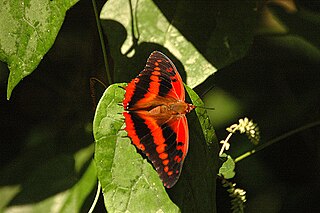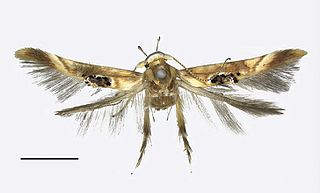Related Research Articles

Bindahara phocides, the plane, is a small butterfly found Indomalayan and Australasian realms that belongs to the lycaenids or blues family.

Symbrenthia lilaea, the peninsular jester, is a species of nymphalid butterfly found in South Asia and Southeast Asia. It forms a superspecies with Symbrenthia hippoclus. There are numerous regional forms, and the taxonomy of the group is not well resolved.

Melanitis phedima, the dark evening brown, is a species of butterfly found flying at dusk. The flight of this species is erratic. They are found in south and southeast Asia.

Arhopala centaurus, the centaur oakblue or dull oakblue, is a species of lycaenid or blue butterfly found in India and southeast Asia to the Philippines.

Virachola perse, the large guava blue, is a species of lycaenid or blue butterfly found in the Indomalayan realm. It was described by William Chapman Hewitson in 1863. The larva feeds on Randia dumetorum.

Bibasis anadi, the plain orange awlet, is a species of hesperid butterfly found in India and Southeast Asia. The butterfly has been reassigned by Vane-Wright and de Jong (2003) to the genus Burara and is considered by them Burara anadi.

Grammodes stolida, the geometrician, is a moth of the family Erebidae. The species was first described by Johan Christian Fabricius in 1775. It is found in Africa, southern Europe, most of Asia and Australia. It migrates to central and northern Europe as far north as England, Denmark and Finland.
Cosmopterix facunda is a moth of the family Cosmopterigidae. It is known from Texas, United States.
Spilosoma roseata is a moth of the family Erebidae. It was described by Walter Rothschild in 1910. It is found on Java in Indonesia.

Charaxes cynthia, the western red charaxes, is a butterfly in the family Nymphalidae. It is found in Senegal, Guinea, Sierra Leone, Liberia, Ivory Coast, Ghana, Nigeria, Cameroon, Gabon, the Republic of the Congo, the Central African Republic, the Democratic Republic of the Congo, Uganda, Angola, Sudan, Uganda, Kenya, Tanzania and Zambia. The habitat consists of primary forests.
Pycnarmon glaucias is a moth in the family Crambidae. It was described by Edward Meyrick in 1894. It is found on the island of Borneo.
Dichomeris hexasticta is a moth in the family Gelechiidae. It was described by Walsingham in 1911. It is found in Mexico (Guerrero).
Recurvaria sticta is a moth of the family Gelechiidae. It is found in Mexico (Guerrero).
Stomopteryx deverrae is a moth of the family Gelechiidae. It was described by Walsingham in 1905. It is found in Algeria and Spain.

Hieromantis puerensis is a moth of the Stathmopodidae family. It is found in Yunnan, China.
Antaeotricha bicolor is a species of moth of the family Depressariidae. It is found in Brazil.
Comocritis thespias is a moth in the family Xyloryctidae. It was described by Edward Meyrick in 1909. It is found in Sri Lanka.
Eupragia solida is a moth in the family Depressariidae. It was described by Walsingham in 1911. It is found in Mexico, where it has been recorded from Tabasco.
Psittacastis trierica is a moth in the family Depressariidae. It was described by Edward Meyrick in 1909. It is found in Bolivia.
Hypertropha thesaurella is a moth in the family Depressariidae. It was described by Edward Meyrick in 1880. It is found in Australia, where it has been recorded from Queensland and New South Wales.
References
| This article on a moth of the subfamily Symmocinae is a stub. You can help Wikipedia by expanding it. |